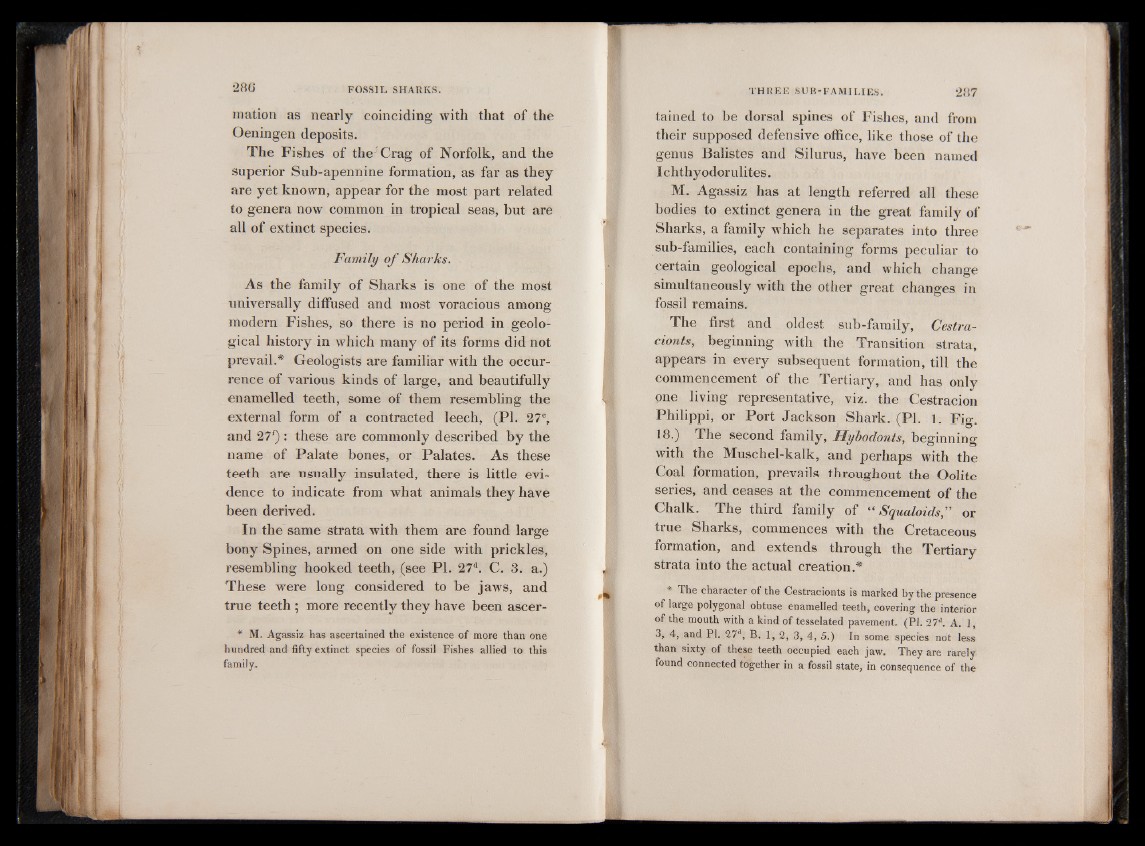
mation as nearly coinciding with that of the
Oeningen deposits.
The Fishes of thef Crag of Norfolk, and the
superior Sub-apennine formation, as far as they
are yet known, appear for the most part related
to genera now common in tropical seas, but are
all of extinct species.
Family of Sharks.
As the family of Sharks is one of the most
universally diffused and most voracious among
modern Fishes, so there is no period in geological
history in which many of its forms did not
prevail.* Geologists are familiar with the occurrence
of various kinds of large, and beautifully
enamelled teeth, some of them resembling the
external form of a contracted leech, (PI. 27e,
and 27f) : these are commonly described by the
name of Palate bones, or Palates. As these
teeth are usually insulated, there is little evidence
to indicate from what animals they have
been derived.
In the same strata with them are found large
bony Spines, armed on one side with prickles,
resembling hooked teeth, (see PI. 27d. C. 3. a.)
These were long considered to be jaws, and
true teeth ; more recently they have been ascer-
* M. Agassiz has ascertained the existence of more than one
hundred and fifty extinct species of fossil Fishes allied to this
family.
tained to be dorsal spines of Fishes, and from
their supposed defensive office, like those of the
genus Balistes and Silurus, have been named
Ichthyodorulites.
M. Agassiz has at length referred all these
bodies to extinct genera in the great family of
Sharks, a family w hich he separates into three
sub-families, each containing forms peculiar to
certain geological epochs, and which change
simultaneously with the other great changes in
fossil remains.
The first and oldest sub-family, Cestra-
cionts, beginning with the Transition strata,
appears in every subsequent formation, till the
commencement of the Tertiary, and has only
one living representative, viz. the Cestracion
Philippi, or Port Jackson Shark. (PI. 1. Fig.
18.) The second family, Hybodonts, beginning
with the Muschel-kalk, and perhaps with the
Coal formation, prevails throughout the Oolite
series, and ceases at the commencement of the
Chalk. The third family of “ Squaloids,” or
true Sharks, commences with the Cretaceous
formation, and extends through the Tertiary
M strata into the actual creation.*
% * The character of the Cestracionts is marked by the presence
of large polygonal obtuse enamelled teeth, covering the interior
of the mouth with a kind of tesselated pavement. (PI. 27d. A. 1,
3, 4, and PI. 27d, B. 1 ,2 , 3, 4, 5.) In some species not less
than sixty of these teeth occupied each jaw. They are rarely
found connected together in a fossil state, in consequence of the